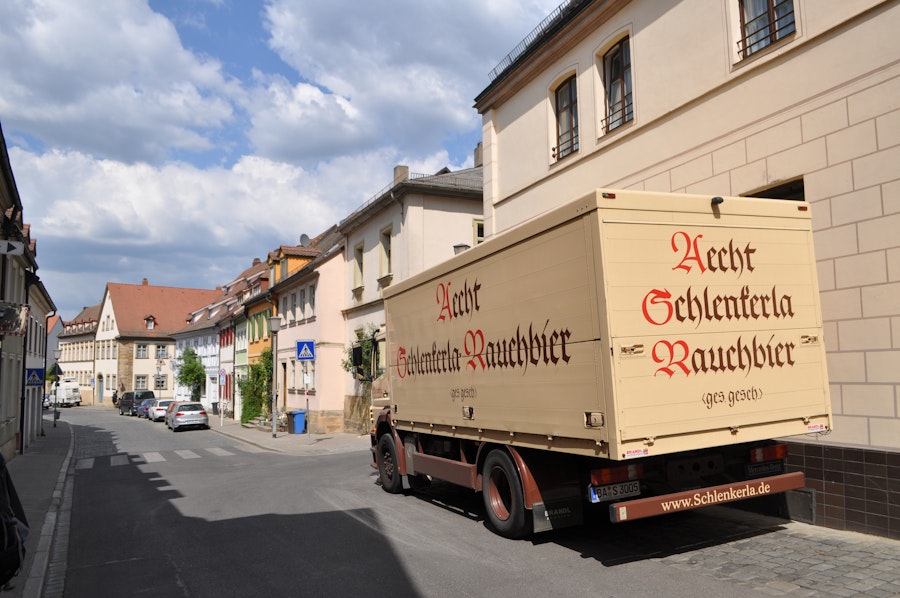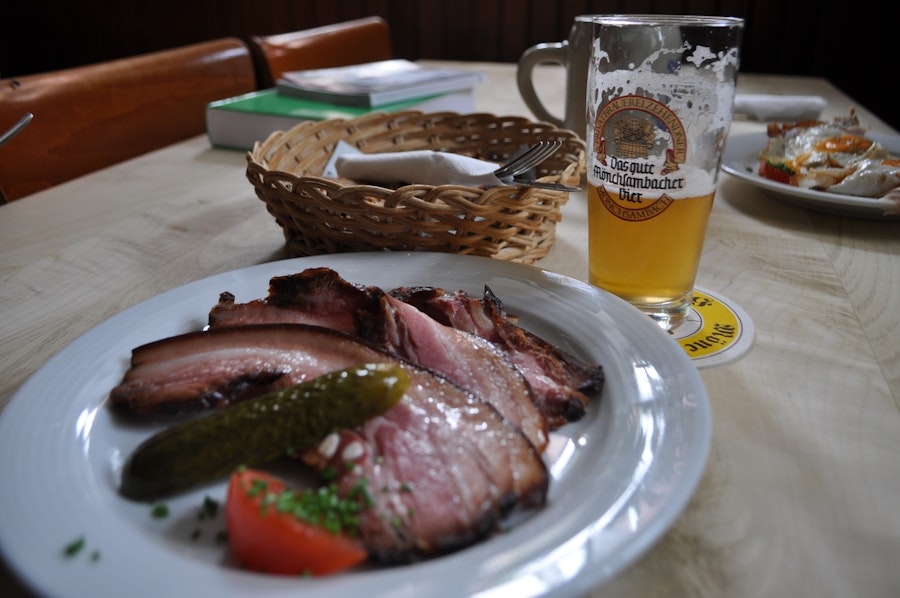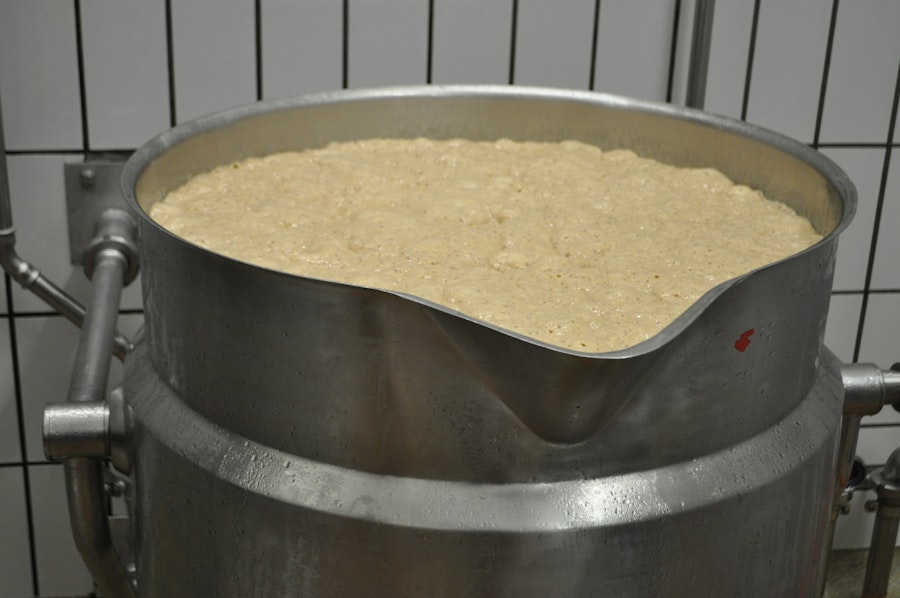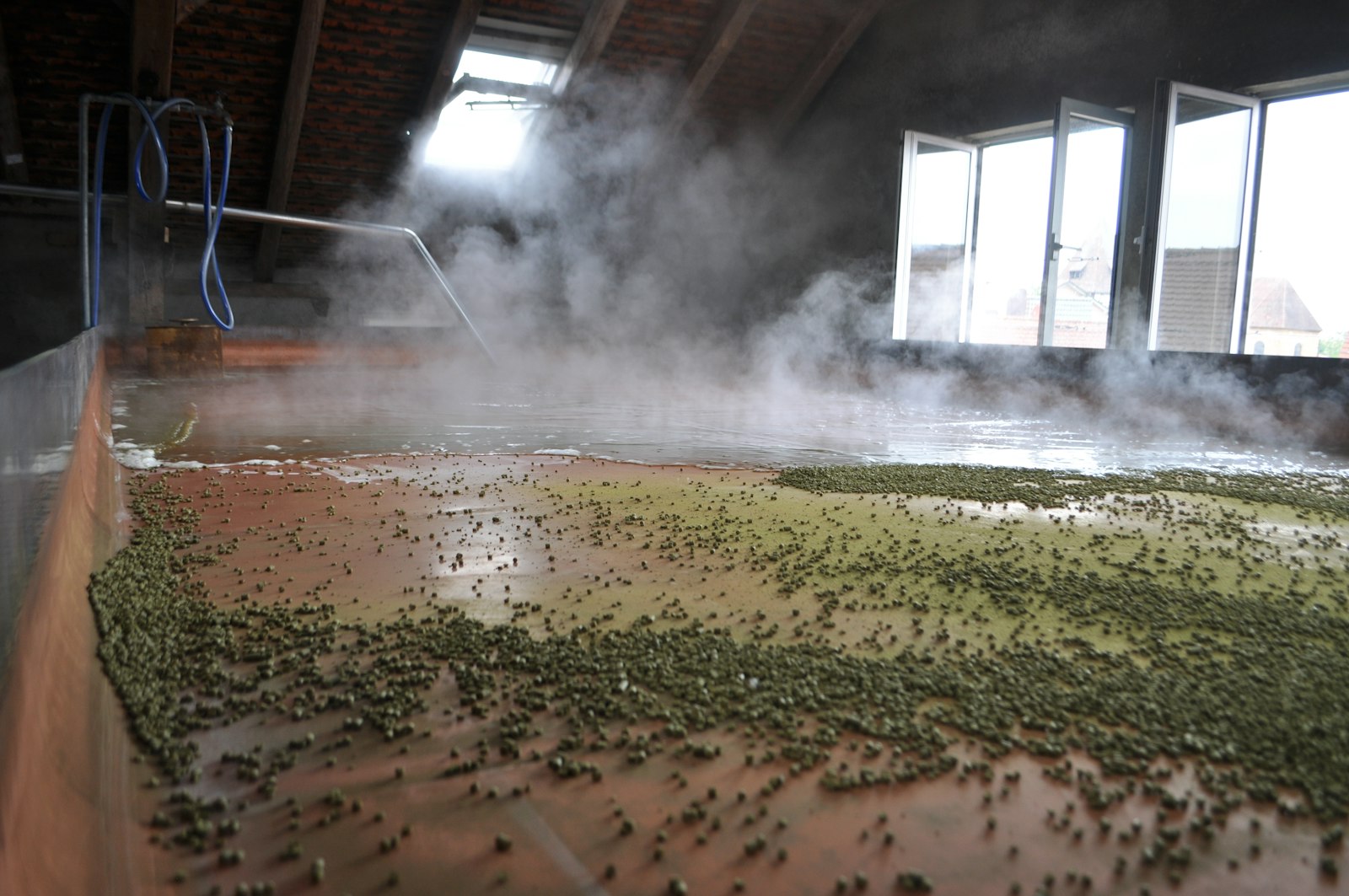The hill that is the beating heart of Hallerndorf is called the Kreuzberg. Walkable from five different villages, the hilltop features three large beer gardens, a brewery, and a church. At the base of the hill is another large beer garden connected to another brewery. The villages themselves feature more beer gardens and more breweries.
This is Upper Franconia, after all. Beer is daily life around here.
One of those nearby villages is Schnaid, home to about 300 people. It’s also the home to the old Friedel brewhouse, now put to use by the Gänstaller family—chiefly Brewmaster Andreas Gänstaller and his daughter, Daniela, also a brewer. The lower part of the building is more than two centuries old. From the upper floors—built just after World War II—you can see the Kreuzberg out the window.
Here is another thing you can see upstairs, in the attic: a wide, riveted copper coolship.
Or rather: You can see it, until the boiling-hot wort hits the pan—littered with a surprising amount of hops pellets for a burst of aroma—and opaque steam rapidly fills the attic. After that, it’s difficult to see anything in there for a while. This coolship is the kind of thing you might expect to see in a lambic brewery, or in an ambitious American wild-beer brewery, or in a museum. Its original purpose, however, has nothing to do with sour beers. It is simply an old-fashioned way to cool wort. Andreas Gänstaller uses it every time he brews lager.
“The wort streams out really clear,” he says. “The beer is much more clear because all the bad stuff goes away in the steam.” Notably, that “bad stuff” includes DMS. Once the wort temperature drops to about 75°C (167°F), Gänstaller drains the wort to a more traditional chiller to bring the temperature down to 10–11°C (50–52°F), then on to fermentation.
Gänstaller’s best sellers are a Kellerbier and a Zwickel, both recognizably traditional but given extra flourish by juicy aroma hopping. His beers are old-wave-new-wave hybrids—full of hops, malt, and creativity, like a smoked imperial India pale lager or a bottom-fermented Russian imperial stout.
Yet he sticks stubbornly to some old-fashioned techniques. These include a traditional decoction mash and properly long lagering times.
Coolships are rare in Franconia, to be sure, but the old methods it represents are not. Decoction mashing and patient lagering remain the norm across Upper Franconia, as they do in nearby Czechia—the two places in the world most famed for their attractive, flavorful lagers.
Does anyone think that’s a coincidence?

The Most Brewery-Rich Region in the World
Most bucket-list beer lovers who visit Upper Franconia probably never manage to leave Bamberg. This is understandable. That city—a UNESCO World Heritage Site with loads of atmospheric pubs and beer gardens and the spiritual home of smoked beer—is a feast of its own. Still, it’s a shame, since the region around Bamberg offers rewarding countryside.
Naturally, those rewards include some of the world’s most rustic and characterful lagers.
They have remained so thanks to local preference and old-fashioned brewing methods. These make sense in a rural, relatively conservative area that has proven resistant to global commercial pressures. Among the evidence: In many country pubs here, you can still find half-liters of local small-batch beer served in stoneware mugs for about $2. In the 1800s, some optimistic German writers dubbed this area Franconian Switzerland, though there are no real mountains. What’s here looks more like the type found in the Ozarks—big rolling hills that occasionally get spiky, invariably covered with trees, the valleys below laced with rivers and patched by green pastures.
These valleys are occasionally punctuated by cute, compact, red tile–roofed villages. These villages are thick with breweries.
Upper Franconia is the most brewery-rich region in the world, per capita, with roughly 200 breweries for one million people. The great majority of breweries are found in those little villages. Drive in random directions around the countryside and you are likely to stumble across several. (Better yet, have someone else drive you.)
Stop into one, order a beer, and ask whether the brewer is around. The brewer is fairly likely to be the person behind the counter. Explain that you’re a hobbybrauer and ask if they still do a decoction mash. Almost invariably, they will say yes and happily offer to show you their kit.
Drink enough of these beers in enough of these places, and you may start to wonder why they taste better than what you find elsewhere, even in Germany. It may well be that the answer is not complicated.
Hey, have you heard the one about decoction being obsolete?
The conventional wisdom these days in brewing texts and various online fora appears to be that decoction is no longer necessary—which, on the face of it, is plainly true, thanks to more-modified malts that are now available. (Though many fail to notice that more old-fashioned, less-modified malts are still available, too, and, in some places, in common use.)
Likewise, it is no longer strictly “necessary” to make a fruit pie from scratch. Don’t you know they sell the fruit in cans—and frozen crusts, too? Some of them are pretty good, too. But given your druthers, which would you rather eat?
Good Cooking
“Those malts are so gelöst.”
Stefan Zehendner, brewer of the highly esteemed Mönchsambacher Lagerbier, is talking about that modern, more-modified type of malt, processed and ready for infusion like tea.
Gelöst, incidentally, can mean deleted or erased. It also means dissolved, which is technically what happens to the internal grain structure as it’s modified during malting. “The malt is crisp or brittle,” he says. “The new kinds of malt are very thin. So they must make infusion with the new malts, and I think decoction is better.” Zehendner is suggesting that modern malts lack something. Do they make good beer? Of course. But cook them in a decoction mash—a process that adds qualities that specialty malts can only simulate—and they fold like a house of cards.
They lose the body and foam stability associated with a proper decoction mash and relatively less-modified malts.
Zehendner, for his lagers, uses 100 percent Pilsner malt from the Bamberger Mälzerei—the neighbor to Weyermann, less known internationally but perhaps more favored among local brewers. It is well-suited to decoction, and any doubters might want to ponder it over a glass of Mönchsambacher—deep burnished gold, with a fresh-sweet-malt center that can stand up to its ample bitterness, topped with typically lush white foam that stays through the end of the glass, leaving stripes of lace all the way down to mark each gulp you’ve taken.
As a young man, Zehendner brewed for two years at Spezial in Bamberg, then studied for two years at Doemens in Munich. After returning to the family brewery—he is the third generation—he and his father updated the beers. They dropped a Märzen and added the Lagerbier. “The Märzen was not so popular at this time,” he says. “It was too malty. And my father preferred the same beer as [I do], a more dry beer, and hoppy.”
They also updated the brewhouse in 2000 and switched from a double- to a single-decoction mash. When the mash reaches 72°C (161°F) Zehendner takes off about a third and brings it to a boil that lasts 5 minutes, then returns it to the main mash. That brings the overall mash to 76°C (169°F) for a brief rest before lautering. “It’s not complicated,” he says. Yet the benefits are many—deeper malt flavor, better balance, more body, and better foam. Like many Bavarian brewers, Zehender also decocts his wheat beers.
“Good cooking is good cooking,” he says.

Decoction Is Better for the Beer
Lest you think that decoction is limited to the antique countryside breweries, it’s worth noting that no less a name than Weihenstephaner, from Helles to Hefeweissbier, still does a double-decoction on all its beers. It’s less clear how many other Bavarian or German breweries still hold to the practice. Step-infusion has become more common in the larger industrial breweries.
Another product of decoction mashing is one of Franconia’s most famous exports: the smoked beers of Schlenkerla.
The Heller-Trum brewery’s Schlenkerla tavern is in the center of Bamberg’s old-town center. Based on some old records, historians believe it has been a brewery pub for at least six centuries—a nice reminder that any current political troubles are the blink of an eye; Germany has seen worse, and Schlenkerla still stands.
Ten minutes’ walk from there, riddling the hill known as Stephansberg, are some deep, cool, arched-ceiling stone cellars that may be as old as the pub. This is where Schlenkerla beer matures for anywhere from six to twenty-six weeks, depending on the recipe. The brewery is upstairs, and so is the malt house.
Fans know that Schlenkerla uses beechwood fires to malt its own barley, giving its beers that distinctive smoked character. Logs are stacked neatly on the ground floor, next to the furnace; the kilning chamber is directly upstairs.
After kilning for twenty hours, the product resembles darkish, smoked Munich malt. It starts at about 50°C (122°F) and at the end reaches 100–105°C (212–220°F). From five tons of barley, they get four tons of malt; they kiln that much three times per week.
What is less well known is that Schlenkerla still brews with a double-decoction mash—though maybe this shouldn’t be surprising, considering the rustic way they malt their barley.
Brewmaster Martin Knab shrugs when asked about this. “The better beers are decocted,” he says, as if everyone knows this. “I think decoction is better for the beer. You get beers with much more body.”
At Schlenkerla, Knab says, they take about half the mash and raise its temperature to 95°C (203°F)—enough to raise the full mash up to 70°C (158°F). Then they take about 30 percent of the mash and boil it, which brings the full mash up to 77°C (171°F). The beer also gets plenty of time in those old sandstone cellars—six weeks for the Märzen, up to fifteen weeks for the Urbock, and about twenty-six weeks for the hefty, oak-smoked Eiche Doppelbock. In the cellars, Knab pours a few glasses directly from the tanks. In the stronger beers, the smoke becomes relatively restrained, and the rich caramelized malt has more to say.
In parts of the cellar are stacks of pitch-lined, wooden casks—holzfass—that await filling and transport down the hill to the pub. The locals prefer to have their glasses filled from these barrels, via spigot and gravity.
“It’s the same beer in the wooden barrel and in the bottle,” Knab says. “You’re not only drinking with your mouth. You’re drinking with your eyes, and it’s the place.” Why then does the beer from the holzfass taste softer, richer, and—frankly—better? Knab shrugs. “The holzfass is sitting for two or three hours, and the carbon dioxide goes a little bit out of the beer.”
The flagship is the Märzen. Style guidelines might say a Märzen should be dark gold or copper-colored, but Schlenkerla’s is a dark chestnut brown. It’s also fairly bitter, especially when fresh, getting about 32 IBUs from an early charge of Hallertauer Magnum in the kettle. Yet it’s balanced by a caramelized malt sweetness that is a joint product of that unique malt and the Maillard reactions in the decoction mash—literally, the cooking and caramelization of the malt. As in other well-brewed and well-poured continental lagers, the foam and lace are resilient.
Smoke is what makes Schlenkerla distinctive—but, arguably, the decoction is what makes it addictive.
A Coolship Lesson
Like other Franconian brewers and drinkers, Stefan Zehendner likes his wooden barrels. Back in Mönchsambach, on a Friday afternoon, he taps a holzfass in time for an armada of cyclists to arrive for lunch. Today, it’s only him and his mother working in the pub, even while a batch brews across the courtyard. Occasionally he runs over to check on things.
For the cyclists, he fills steinkrug after steinkrug. He also offers to fill an elegant willibecher glass, to better show off the foam and color. All the Mönchsambacher beers are unfiltered, including the lagers, which often show a light haze but are always bright, never murky. He lagers them for at least five or six weeks; his bock beers get at least twelve.
When they updated the brewhouse in 2000, the Zehendners got rid of something besides that second decoction step. At one point, Zehendner produces a photo of a young man with a hose cleaning what appears to be a coolship? “That’s me,” he says.
The coolship in the picture went to nearby Schesslitz and the Barth-Senger brewery, which closed in 2012. Now his old coolship is just sitting there. It may yet return. “I told them, ‘Before you send my coolship to America, I’ll buy my coolship back!’” “For 30 years we left the wort overnight in the coolship, and in the morning we gave it to the fermentation.” Then one day he did a lab analysis of the beer and found small amounts of bacteria. They were not spoiling the beer, as far as he knew, but the potential was there. So they switched to more modern chilling methods.
Let’s be clear: Coolships do not make beer sour—not necessarily. They have become part of the myth and legend around lambic beers, but much of that magic happens in the barrels. Coolships used to be a fairly common sight in breweries of all sorts.
Like elsewhere, they have become rare in Germany. Gänstaller says he knows of only four in Franconia that are still used. Just east of there, in the Oberpfalz region, the communal Zoigl breweries still have coolships in their attics and allow the beer to cool there overnight—with few, if any, ill effects. On the other side of the country, the famed Uerige altbier brewery in Düsseldorf still uses an attic coolship for an initial drop in temperature, much like Gänstaller. There may be a few others around Germany. But for the most part, they have disappeared.
Now, Zehendner says he might try it again, but in a way similar to his friend Gänstaller, who brews fifteen miles from here—by moving it to a traditional chiller after an initial drop to 75°C (167°F). “I think now you can do it better,” he says. Are these the early stirrings of a coolship comeback?

Questioning Shortcuts
It’s 3:00 p.m. in Schnaid, and Andreas Gänstaller is filling his coolship again. This time, a handful of international visitors has arrived for the show.
The wort that hits the pan has just gone through a 70-minute boil, which followed a double-decoction mash. Gänstaller says he warms the mash to 64°C (147°F) before removing one-third of it. He raises that portion gradually and pauses briefly at two rests—72°C (162°F) and 77°C (169°F)—before bringing it boil. This brings the main mash to 72°C (162°F), then he removes one-third again to boil, which brings the overall mash to 76°C (169°F). Then it’s time to lauter.
After the coolship show, the fog clears up in the attic. The green hops trub leaves patterns behind that resemble lightning strikes or river deltas. They are fractals, and each branch leads off to new branches, never returning to the same spot.
A thought: Brewing is by far the coolest subgenre of organic chemistry because it leads to beer. Before that happens, though, brewers must navigate a vast number of choices—in equipment, process, temperature, ingredients, and especially judgements about time. These lead to an infinite range of outcomes.
Each choice branches off into a new direction, leading to beer that has quite literally never been brewed before.
Isn’t it ironic, then, that brewers love shortcuts? Everything we know about organic chemistry tells us there is no such thing. Shortcuts in lager brewing might or might not lead to great beer. But they can never lead to the same place.
The brewing experts can produce all sorts of research on efficiencies and malt modification to back up their arguments. Often they are suspiciously short in the realm of sensory evaluation.
What tastes better, and why? For that sort of research, one might suggest that a good place to start might be the Kreuzberg.

